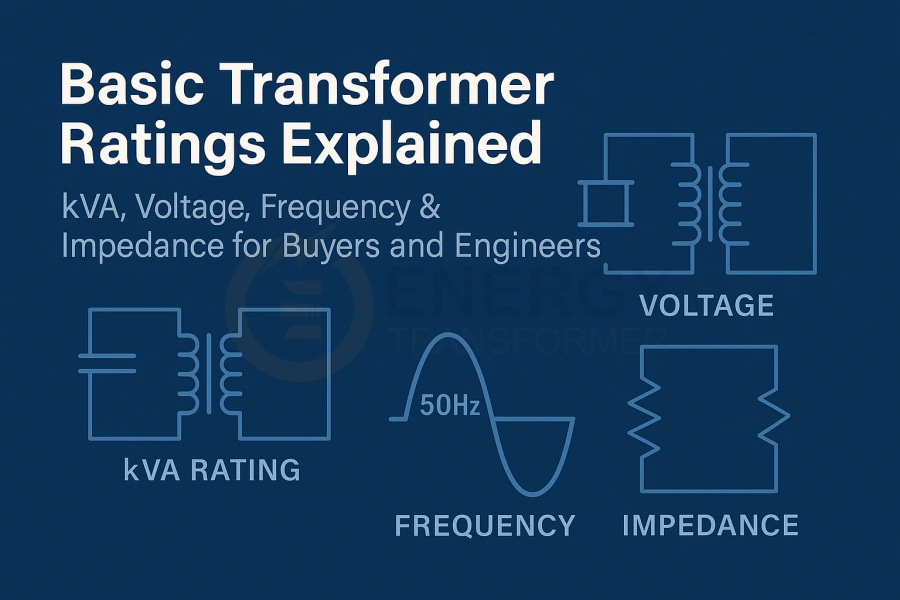Understand Key Electrical Specifications Before You Buy a Power Transformer
Choosing the right power transformer is crucial for the success and safety of any electrical project. Whether you're a seasoned engineer, a procurement specialist, or a project manager, understanding fundamental transformer ratings is non-negotiable. Misinterpreting these specifications can lead to costly equipment failure, inefficient operations, or even dangerous electrical hazards. This guide from Energy Transformer will walk you through the essential parameters you need to know to make informed decisions.
What Are Transformer Ratings?
At its core, a transformer rating is a set of performance indicators defined by the manufacturer. These critical transformer specifications are typically etched or printed on the nameplate data of every unit. This nameplate serves as the ultimate source of truth for the transformer's capabilities and limitations, making it the primary reference point during the selection process.
kVA Rating – Transformer Capacity
The kVA rating (kilovolt-amperes) is arguably the most critical specification, representing the apparent power capacity of a transformer. It indicates the maximum load the transformer can deliver without exceeding its thermal limits. Unlike kW (kilowatts), kVA accounts for both active power (kW) and reactive power (kVAR), making it a more comprehensive measure of the transformer's total load capacity or power rating.
The key distinction between kVA and kW lies in the power factor. kW = kVA Power Factor. For instance, a 10 kVA pole mounted transformer can supply a total apparent power of 10 kVA. If your connected load has a power factor of 0.8, the transformer can deliver 8 kW of active power (10 kVA 0.8). It's vital to size your transformer based on the kVA rating to ensure it can handle the total current draw of your equipment.
Voltage Ratings – Primary and Secondary
Transformer voltage ratings specify the intended input (primary) and output (secondary) voltages.
-
The primary voltage refers to the voltage applied to the input winding.
-
The secondary voltage is the voltage induced in the output winding, which is supplied to your load.
For example, a common distribution transformer might be rated as 11kV/400V. This means it's designed to step down an 11,000-volt input to a 400-volt output. It's crucial to match these voltage ratings to your local grid standards and equipment requirements. For instance, North America typically uses 120V/240V/480V/600V systems, while Europe and many other regions primarily use 230V/400V.
Read More:Transformer Efficiency Standards and Loss Analysis: A Complete Guide (IEC & DOE Compliant)
Frequency Rating – 50 Hz vs 60 Hz
The frequency rating (measured in Hertz, Hz) indicates the alternating current (AC) frequency for which the transformer is designed. The most common frequencies are 50 Hz and 60 Hz. The United States, Canada, and parts of Central and South America primarily operate on 60 Hz, while Europe, Asia, Africa, and Australia largely use 50 Hz.
It is paramount that the transformer's frequency rating matches the frequency of your electrical grid. Using a transformer at the wrong frequency can lead to severe issues:
-
50 Hz transformer on a 60 Hz supply: The magnetic core may not saturate properly, leading to higher magnetizing current and potentially higher losses, though it is often less damaging than the reverse.
-
60 Hz transformer on a 50 Hz supply: The transformer's impedance will decrease, leading to significantly higher magnetizing current, core saturation, excessive heat generation, and potential damage or catastrophic failure.
In short, while some limited operation might be technically possible in specific scenarios, it is generally not recommended to use a transformer designed for one frequency on a different frequency system due to the risks of damage and significant efficiency reduction.
Impedance – What It Means and Why It Matters
Transformer impedance is a crucial parameter, typically expressed as a percentage (%) or per unit (pu). It represents the total opposition to current flow within the transformer windings, primarily due to resistance and leakage reactance.
The impedance value is vital for several reasons:
-
Parallel Operation: For two or more transformers to share a load effectively when connected in parallel, their impedance values should be closely matched (typically within 7.5%). Significant differences can lead to unequal load sharing, potentially overloading one transformer.
-
Short-Circuit Protection: Impedance plays a critical role in calculating the maximum short-circuit current that can flow through the transformer. A higher impedance limits the fault current, reducing the stress on downstream equipment and simplifying the design of protective devices. For example, a transformer with 5% impedance will allow 20 times its full load current to flow during a bolted short circuit ($text{100%} / text{5%}$), whereas a 2.5% impedance transformer would allow 40 times. This information is essential for selecting appropriate circuit breakers and fuses.
-
Voltage Regulation: Impedance also affects voltage drop under load. A lower impedance transformer will exhibit better voltage regulation (less voltage drop from no-load to full-load) but will allow higher fault currents.
Where to Find These Ratings – Reading the Nameplate
All the essential transformer ratings are prominently displayed on the transformer nameplate or electrical data label. Here's a typical list of information you'll find:
-
kVA Rating: (e.g., 500 kVA)
-
Primary Voltage: (e.g., 13.8 kV)
-
Secondary Voltage: (e.g., 480/277 V)
-
Frequency: (e.g., 60 Hz)
-
Impedance: (e.g., 5.75%)
-
Insulation Class: (e.g., 220°C)
-
Temperature Rise: (e.g., 115°C)
-
Connection Diagram: (e.g., Dyn11)
-
Manufacturer: (e.g., Energy Transformer)
-
Serial Number:
-
Weight:
-
Cooling Method: (e.g., AN, AA, OA)
Always refer to the nameplate for the most accurate and up-to-date information when specifying or troubleshooting a transformer.
Common Mistakes to Avoid When Interpreting Ratings
Even experienced professionals can make common errors when interpreting transformer ratings:
-
Using kW Instead of kVA: Remember, transformers are rated in kVA for their thermal capacity, not kW. Always consider the power factor of your load.
-
Ignoring Frequency Mismatch: As discussed, operating a transformer at an incorrect frequency can lead to significant damage or drastically reduced efficiency.
-
Misunderstanding Impedance Meaning: Don't just look at the number. Understand its implications for fault current and parallel operation.
-
Neglecting Regional Standards: Be aware of regional differences in voltage and frequency standards (e.g., ANSI in North America vs. IEC in Europe and other parts of the world).
Conclusion
Understanding these fundamental transformer ratings—kVA, voltage, frequency, and impedance—is absolutely critical for proper selection, safe operation, and efficient integration of power transformers into your electrical systems. By paying close attention to these specifications, buyers, engineers, and project managers can avoid costly errors and ensure the longevity and reliability of their equipment.
Need help with your next transformer project?
At Energy Transformer, we specialize in providing high-quality, reliable power transformers tailored to your specific needs. Contact us today to discuss your requirements or to get a quote. Our team of experts is ready to assist you in selecting the perfect transformer for your application.

